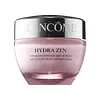What's inside
What's inside
 Key Ingredients
Key Ingredients

 Benefits
Benefits

 Concerns
Concerns

 Ingredients Side-by-side
Ingredients Side-by-side

Water
Skin ConditioningGlycerin
HumectantButylene Glycol
HumectantPhenyl Trimethicone
Skin ConditioningPropanediol
SolventSucrose
HumectantHydroxyethyl Urea
HumectantAlteromonas Ferment Extract
Skin ConditioningHydrolyzed Rice Extract
Skin ConditioningAcetyl Glucosamine
Skin ConditioningTrehalose
HumectantAlgae Extract
EmollientCaffeine
Skin ConditioningCholesterol
EmollientAloe Barbadensis Leaf Water
MaskingSodium Hyaluronate
HumectantPentaerythrityl Tetraethylhexanoate
EmollientDextrin Palmitate
EmulsifyingAcrylates/C10-30 Alkyl Acrylate Crosspolymer
Emulsion StabilisingSorbitol
HumectantSodium Polyaspartate
HumectantTocopheryl Acetate
AntioxidantCarbomer
Emulsion StabilisingDehydroxanthan Gum
Emulsion StabilisingCitric Acid
BufferingTetrahexyldecyl Ascorbate
AntioxidantBenzophenone-4
UV AbsorberPentaerythrityl Tetra-Di-T-Butyl Hydroxyhydrocinnamate
AntioxidantSodium Hydroxide
BufferingSodium Citrate
BufferingDisodium EDTA
BHT
AntioxidantChlorphenesin
AntimicrobialPhenoxyethanol
PreservativeCI 14700
Cosmetic ColorantCI 19140
Cosmetic ColorantWater, Glycerin, Butylene Glycol, Phenyl Trimethicone, Propanediol, Sucrose, Hydroxyethyl Urea, Alteromonas Ferment Extract, Hydrolyzed Rice Extract, Acetyl Glucosamine, Trehalose, Algae Extract, Caffeine, Cholesterol, Aloe Barbadensis Leaf Water, Sodium Hyaluronate, Pentaerythrityl Tetraethylhexanoate, Dextrin Palmitate, Acrylates/C10-30 Alkyl Acrylate Crosspolymer, Sorbitol, Sodium Polyaspartate, Tocopheryl Acetate, Carbomer, Dehydroxanthan Gum, Citric Acid, Tetrahexyldecyl Ascorbate, Benzophenone-4, Pentaerythrityl Tetra-Di-T-Butyl Hydroxyhydrocinnamate, Sodium Hydroxide, Sodium Citrate, Disodium EDTA, BHT, Chlorphenesin, Phenoxyethanol, CI 14700, CI 19140
Water
Skin ConditioningGlycerin
HumectantCyclohexasiloxane
EmollientIsononyl Isononanoate
EmollientCaprylic/Capric Triglyceride
MaskingButylene Glycol
HumectantCetyl Alcohol
EmollientStearyl Dimethicone
EmollientGlyceryl Stearate
EmollientStearic Acid
CleansingStearyl Alcohol
EmollientPEG-8 Stearate
EmulsifyingSynthetic Wax
AbrasiveCyclopentasiloxane
EmollientLecithin
EmollientSodium Dextran Sulfate
Gel FormingSodium Chloride
MaskingHydroxypalmitoyl Sphinganine
Skin ConditioningSodium Hyaluronate
HumectantPaeonia Suffruticosa Extract
Skin ConditioningPEG-15 Stearate
EmulsifyingEugenol
PerfumingEthylparaben
PreservativeTriethanolamine
BufferingCrithmum Maritimum Extract
Skin ConditioningPalmitic Acid
EmollientSilica
AbrasiveCellulose Acetate Butyrate
Polyphosphorylcholine Glycol Acrylate
Polycaprolactone
StabilisingPolyvinyl Alcohol
Poloxamer 188
EmulsifyingAmmonium Polyacryloyldimethyl Taurate
Emulsion StabilisingDimethiconol
EmollientLimonene
PerfumingBenzyl Alcohol
Perfuming2-Oleamido-1,3-Octadecanediol
Skin ConditioningCaprylyl Glycol
EmollientAlpha-Isomethyl Ionone
PerfumingMoringa Oleifera Seed Extract
Skin ConditioningCeramide NP
Skin ConditioningDisodium EDTA
Rosa Gallica Flower Extract
AstringentMethylparaben
PreservativeButylphenyl Methylpropional
PerfumingOctyldodecanol
EmollientParfum
MaskingPhenoxyethanol
PreservativeWater, Glycerin, Cyclohexasiloxane, Isononyl Isononanoate, Caprylic/Capric Triglyceride, Butylene Glycol, Cetyl Alcohol, Stearyl Dimethicone, Glyceryl Stearate, Stearic Acid, Stearyl Alcohol, PEG-8 Stearate, Synthetic Wax, Cyclopentasiloxane, Lecithin, Sodium Dextran Sulfate, Sodium Chloride, Hydroxypalmitoyl Sphinganine, Sodium Hyaluronate, Paeonia Suffruticosa Extract, PEG-15 Stearate, Eugenol, Ethylparaben, Triethanolamine, Crithmum Maritimum Extract, Palmitic Acid, Silica, Cellulose Acetate Butyrate, Polyphosphorylcholine Glycol Acrylate, Polycaprolactone, Polyvinyl Alcohol, Poloxamer 188, Ammonium Polyacryloyldimethyl Taurate, Dimethiconol, Limonene, Benzyl Alcohol, 2-Oleamido-1,3-Octadecanediol, Caprylyl Glycol, Alpha-Isomethyl Ionone, Moringa Oleifera Seed Extract, Ceramide NP, Disodium EDTA, Rosa Gallica Flower Extract, Methylparaben, Butylphenyl Methylpropional, Octyldodecanol, Parfum, Phenoxyethanol
 Reviews
Reviews

Ingredients Explained
These ingredients are found in both products.
Ingredients higher up in an ingredient list are typically present in a larger amount.
Butylene Glycol (or BG) is used within cosmetic products for a few different reasons:
Overall, Butylene Glycol is a safe and well-rounded ingredient that works well with other ingredients.
Though this ingredient works well with most skin types, some people with sensitive skin may experience a reaction such as allergic rashes, closed comedones, or itchiness.
Learn more about Butylene GlycolDisodium EDTA plays a role in making products more stable by aiding other preservatives.
It is a chelating agent, meaning it neutralizes metal ions that may be found in a product.
Disodium EDTA is a salt of edetic acid and is found to be safe in cosmetic ingredients.
Learn more about Disodium EDTAGlycerin is already naturally found in your skin. It helps moisturize and protect your skin.
A study from 2016 found glycerin to be more effective as a humectant than AHAs and hyaluronic acid.
As a humectant, it helps the skin stay hydrated by pulling moisture to your skin. The low molecular weight of glycerin allows it to pull moisture into the deeper layers of your skin.
Hydrated skin improves your skin barrier; Your skin barrier helps protect against irritants and bacteria.
Glycerin has also been found to have antimicrobial and antiviral properties. Due to these properties, glycerin is often used in wound and burn treatments.
In cosmetics, glycerin is usually derived from plants such as soybean or palm. However, it can also be sourced from animals, such as tallow or animal fat.
This ingredient is organic, colorless, odorless, and non-toxic.
Glycerin is the name for this ingredient in American English. British English uses Glycerol/Glycerine.
Learn more about GlycerinPhenoxyethanol is a preservative that has germicide, antimicrobial, and aromatic properties. Studies show that phenoxyethanol can prevent microbial growth. By itself, it has a scent that is similar to that of a rose.
It's often used in formulations along with Caprylyl Glycol to preserve the shelf life of products.
Sodium Hyaluronate is hyaluronic acid's salt form. It is commonly derived from the sodium salt of hyaluronic acid.
Like hyaluronic acid, it is great at holding water and acts as a humectant. This makes it a great skin hydrating ingredient.
Sodium Hyaluronate is naturally occurring in our bodies and is mostly found in eye fluid and joints.
These are some other common types of Hyaluronic Acid:
Learn more about Sodium HyaluronateWater. It's the most common cosmetic ingredient of all. You'll usually see it at the top of ingredient lists, meaning that it makes up the largest part of the product.
So why is it so popular? Water most often acts as a solvent - this means that it helps dissolve other ingredients into the formulation.
You'll also recognize water as that liquid we all need to stay alive. If you see this, drink a glass of water. Stay hydrated!
Learn more about Water